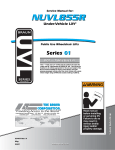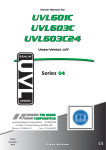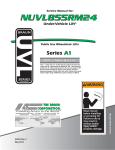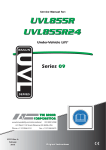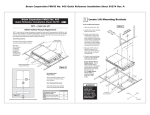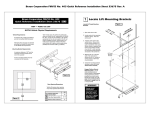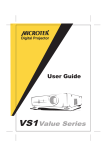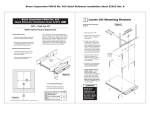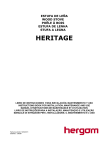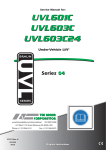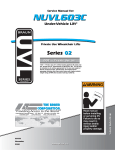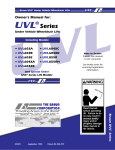Download Braun NUVL855RM24 Wheelchair User Manual
Transcript
CJKA-**GB') 31937 Under-Vehicle Lift® Ope ra Man tor' ua s l DOT — Public Use Lift “DOT — Public Use Lift” verifies that this platform lift meets the “public use lift” requirements of FMVSS No. 403. This lift may be installed on all vehicles appropriate for the size and weight of the lift, but must be installed on buses, school buses, and multipurpose passenger vehicles other than motor homes with a gross vehicle weight rating (GVWR) that exceeds 4,536 kg (10,000 lb). International Corporate Hdqrs: P.O. Box 310 Winamac, IN 46996 USA (574) 946-6153 FAX: (574) 946-4670 1-800-THE LIFT ® www.braunlift.com TM TM 34407 October 2007 ® ® Read manual before operating lift. Failure to do so may result in serious bodily injury and/or property damage. Keep manual in lift storage pouch. Braun UVL Series Operator's Manual Public Use Wheelchair Lifts "Providing Access to the World" WARNING Operator's Manual Operator's Manual for: Congratulations We at The Braun Corporation wish to express our fullest appreciation on your new purchase. With you in mind, our skilled craftsmen have designed and assembled the finest lift available. This manual includes safety precautions, lift operating instructions, manual operating instructions, and instructions for maintenance and lubrication procedures. Your lift is built for dependability, and will bring you years of pleasure and independence, as long as maintenance is performed regularly and the lift is operated by an instructed person. Sincerely, THE BRAUN CORPORATION Ralph W. Braun Chief Executive Officer Contents Warranty/Registration Instructions .................. 2, 3 Handrail Operating Instructions ............................... 21 Lift Terminology Lift Passengers Lift Terminology Illustration ........................................ 4 Passenger Orientation (Boarding Direction) ..... 22 Introduction ................................................................ 5 Standees ........................................................... 22 Direction .................................................................... 5 Yellow Boundaries ...................................... 22, 23 Lift Components .................................................... 6, 7 Vehicle (Floor Level) Loading and Vehicle and Lift Interlocks ......................................... 7 Unloading .................................................... 23, 24 Lift Actions and Functions .......................................... 8 Wheelchair-Equipped Occupant Seat Belts ..... 24, 25 Lift Operation Safety Operation Procedure Review ................................. 25 Safety Symbols ......................................................... 9 Preventive Maintenance ......................................... 26 Lift Operation Safety Precautions ...................... 10-14 Lift Operating Instructions ............................. 27-29 Operation Notes and Details NHTSA Operations Checklist .............................. 30 Introduction/Lift Access Doors and Interlocks ......... 15 Manual Operating Instructions ....................... 31-35 General Safety ......................................................... 16 Decals and Antiskid ........................................ 36-39 Control Switches ..................................................... 16 Maintenance and Lubrication ......................... 40-48 Lift Features Inner Roll Stop ............................................ 17, 18 Outer Barrier ............................................... 18, 19 Barrier, Handrail and Belt Manual Operation ........... 20 Page 1 Warranty and Registration Instructions Immediately upon receiving your lift, examine the unit for any damage. Notify the carrier at once with any claims. Two warranty/registration cards (shown below) are protected in a clear envelope and attached to the lift protective shipping wrap. The sales representative must process one of the cards. The consumer must fill out the other card and mail it to The Braun Corporation. The warranty is provided on the back cover of this manual. The warranty cards must be processed to activate the warranty. Two Braun Serial No./Series No. identification tags are posted on the lift. One I.D. tag (shown below) is located on the left platform side plate (outboard end). A second I.D. tag is located on the base of the pump module. This I.D. tag contains the product identification information provided on the Warranty/Registration card. Record the information in the space provided on the next page. This information must be provided when filing a warranty claim or ordering parts. Series No. Model No. The Braun Corporation 1-800-THE-LIFT TM BRAUNLIFT.COM TM Serial No. DOT Private Use Lift MODEL# OWNER'S WARRANTY REGISTRATION NUVL855RM24 NUVL855RM24 Max. Lifting Capacity - 700Lbs. 01-00025 SERIAL NUMBER 01-00025 PURCHASED FROM OWNER DATE INSTALLED MFG DATE NAME 07/09/2007 ADDRESS CITY TELEPHONE STATE ZIP TO VALIDATE WARRANTY REGISTRATION CARDS MUST BE RETURNED TO THE BRAUN CORPORATION. Page 2 Sample Warranty/Registration Card Sample Serial No./Series No. Identification Tag Warranty and Registration Instructions Model No. Serial No. Series No. Date of Manufacture Note: This information must be provided when filing a warranty claim or ordering parts. Keep for future use. Page 3 Hydraulic Cylinders Lift Terminology Illustration Li ft H ou si ng Platform Cable-activated Manual Release System Lift Mounting Bracket Clamps(6) WARN ING Push manu T-hand and ally le lock out movein fully to Failurbefore engagplatfo and resulte to drivine rm deplo in lock gplatfo in uninteplatfovehiclrm platfoyment resultrm . nded rm e. may and/orin deploUninte platfo seriouymentnded rm prope s may rty bodily damag injury Do not e. remo ve! Hand-held Attendants Control Box 81823 Ca rria ge Inner Roll Stop Rolling Horizontal Arms Torque Tube Outer Barrier Actuator JK A Right Outboard P Left la tfo rm Inboard Lifting Arms Manual Fold Shield Handrails with Belt Page 4 Two-Stage Outer Barrier Lift Terminology Introduction: Braun NUVL Series lifts are ADA compliant and comply fully with National Highway Traffic Safety Administration (NHTSA) specifications. The NUVL855RM24 is commercial oriented (intended for operation by an attendant). Public Use NUVL lift models provide fully automatic operation of deploy (extend), up, down and stow (retract) lift functions. The NUVL855RM24 can be interfaced for fully automatic operation of the power door system. Manual operating procedures are required for the shield handrails and interlocking belt. Refer to the Lift Terminology Illustration for identification of lift components. Basic lift operation procedures are identical for all NUVL Series lift models. The operating instructions contained in this manual address the lift control switches and the corresponding lift functions. Operating procedures for the shield handrails and interlocking belt are provided. Instructions are provided for manual operation of the lift in event of power or equipment failure. Terminology: Become familiar with the terminology that will be used throughout this manual. Become familiar with the identification of lift components and their functions. Contact your lift sales representative or call The Braun Corporation at 1-800THE LIFT® if any of this information is not fully understood. Direction: The terms "left," "right," "inboard," and "outboard" will be used throughout this manual to indicate direction (as viewed from outside the vehicle looking directly at the lift). Refer to the Lift Terminology Illustration for clarification of direction terms. Page 5 Lift Terminology Lift Components Refer to the Lift Terminology Illustration on page 4. Pump Module: The remote mounted pump module consists of the main hydraulic pump, the manual hand pump, the logic control board and other electrical components that power the lift electric/hydraulic systems. Hand-held Pendant Control: The hand-held pendant is equipped with four push button switches, (DOOR, STOW, DOWN and UP). The momentary switches activate the automatic lift functions. Simply press the switch labled for the intended function. The lift function labels illuminate to identify the function(s). Details Page 6 regarding the control switches and their functions are provided in the Lift Operation section. Lift Housing: The lift housing is the metal structure (casing) mounted under the vehicle which contains and protects the platform carriage assembly. The housing contains all lift components except the power (pump) module when the lift is in the stowed position. Platform Carriage Assembly: The platform carriage assembly includes the platform assembly, the lifting arms, the rolling horizontal arms that carry the platform assembly in and out of the housing and the electrical/hydraulic drive components that power the lift. Platform Assembly: The lift platform assembly consists of the flat aluminum plate upon which the wheelchair is positioned, the outer barriers, the inner roll stop and shield handrails. Outer Barrier: The two-stage outer barrier system consists of a spring-loaded tall barrier and an electric actuator-driven short barrier. The two-stage outer barrier provides a ramp for wheelchair loading and unloading at ground level. Photos and further details are provided in the Operation Notes and Details section (pages 18-21). Inner Roll Stop: The NUVL855RM24 is equipped with an automatic inner roll stop that also serves as the bridge plate. The Lift Terminology inner roll stop bridges the gap between the lift platform and the vehicle floor. The inner roll stop automatically rotates from the horizontal position to the vertical position as the lift lowers and raises. Further details regarding the automatic mechanical inner roll stop are provided on pages 17 and 18. Platform Cable-activated Manual Release System: A cableactivated manual release system releases the platform carriage assembly drive chain to allow the platform carriage assembly to be manually moved out (extended) or moved in (retracted), should it be necessary. Complete details and operating procedures are provided on page 32. Vehicle and Lift Interlocks Braun Corporation NUVL Series lifts comply fully with all NHTSA vehicle and lift interlock specifications. Vehicle movement is prohibited unless the lift is fully stowed and the lift will not function unless the vehicle is parked and secured. cannot be stowed if occupied. The lift platform cannot be raised or lowered unless the roll stop and outer barriers are deployed (up). The NUVL855RM24 features a visible and audible threshold warning system that will activate if the threshold area is occupied when the platform is one inch or more below floor level. The inner roll stop and outer barriers sense weight to prohibit lift operation. The lift will not function if the inner roll stop or outer barriers are occupied. The lift platform Page 7 Lift Terminology Lift Actions and Functions: Deploy (Extend): Lift deployment is the action of the lift platform carriage assembly extending (moving outward) from the housing and lowering to ground level when the DOWN switch is activated or raising to floor level when the UP switch is activated. Stow (Retract): Stow is the action of the lift platform and carriage assembly retracting (moving inward) into the lift housing. During the stow function, the platform will automatically raise or lower to stow level before retracting into the housing. DOWN - Platform Lower: Down is the action of the platform lowering from stow or floor level posi- Page 8 tion to fully-lowered (ground level) position when the DOWN switch is pressed. DOWN - Outer Barrier Unfold (Down) - When the platform reaches the fully-lowered (ground) position and the DOWN switch is continued to be pressed, the outer barriers rotate downward from vertical position to ramp position. UP - Outer Barrier Fold (Raise): From ground level, the UP function automatically raises (rotates) the actuator activated outer barriers to the upright (vertical) position before the platform raises. UP - Platform Raise: Up is the action of the platform raising from stow level or ground level to floor level (fully-raised) position when the UP switch is pressed. When the lift is fully lowered, pressing the UP switch first raises the outer barrier. Note: The lift platform will not raise if the outer barriers are not in the upright (vertical) position. This is a built in safety feature. Stow Level: Stow level is the height that the platform and carriage assembly moves in and moves out of the lift housing. Floor Level: Floor level is the height that the platfom and carriage assembly raises to in order for the wheelchair passenger to enter and exit the vehicle (fully raised position). Lift Operation Safety Safety Symbols SAFETY FIRST! Know That.... All information contained in this manual and supplements (if included), is provided for your safety. Familiarity with proper operation instructions as well as proper maintenance procedures are necessary to ensure safe, troublefree operation. Safety precautions are provided to identify potentially hazardous situations and provide instruction on how to avoid them. A D B WARNING This symbol indicates important safety information regarding a potentially hazardous situation that could result in serious bodily injury and/or property damage. C CAUTION This symbol indicates important information regarding how to avoid a hazardous situation that could result in minor personal injury or property damage. Note: Additional information provided to help clarify or detail a specific subject. These symbols will appear throughout this manual as well as on the labels posted on your lift. Recognize the seriousness of this information. Page 9 Lift Operation Safety Lift Operation Safety Precautions WARNING If the lift operating instructions, manual operating instructions and/or lift operation safety precautions are not fully understood, contact The Braun Corporation immediately. Failure to do so may result in serious bodily injury and/or property damage. WARNING Read manual and supplement(s) before operating lift. Read and become familiar with all safety precautions, lift operation notes and details, operating instructions and manual operating instructions before operating the lift. Note: Wheelchair passengers and all transit agency personnel (drivers and wheelchair lift attendants) must read and become familiar with the contents of this manual and supplement(s) before operation. WARNING Load and unload on level surface only. WARNING Engage vehicle parking brake before operating lift. WARNING Provide adequate clearance outside the vehicle to accommodate the lift before opening lift door(s) or operating lift. WARNING Inspect lift before operation. Do not operate lift if you suspect lift damage, wear or any abnormal condition. WARNING Keep operator and bystanders clear of area in which the lift operates. Page 10 Lift Operation Safety WARNING Whenever a wheelchair passenger (or standee) is on the platform, the: • Handrail belt must be latched. • Passenger must be positioned in the center of the platform. • Wheelchair brakes must be locked • Inner roll stop and outer barriers must be up (vertical) • Passenger should grip both handrails (if able). WARNING Load and unload clear of vehicular traffic. WARNING Do not overload or abuse. The load rating applies to both the raising and lowering functions - continuous lifting capacity is 700 lbs. WARNING Discontinue lift use immediately if any lift or vehicle interlock does not operate properly. WARNING Do not operate or board the lift if you or your lift operator are intoxicated. WARNING Do not raise front wheelchair wheels (pull wheelie) when loading (boarding) the platform. WARNING Open lift door(s) fully and secure before operating lift. WARNING Position and secure (buckle, engage, fasten, etc.) the wheelchair-equipped occupant seat belt (torso restraint) before loading onto the wheelchair lift platform. WARNING Fold outer barrier and handrails down to platform before stowing lift. Page 11 Lift Operation Safety Lift Operation Safety Precautions (continued) WARNING If the lift operating instructions, manual operating instructions and/or lift operation safety precautions are not fully understood, contact The Braun Corporation immediately. Failure to do so may result in serious bodily injury and/or property damage. WARNING Lift attendants must ensure that lift occupants keep hands, arms and all other body parts within the lift occupant area and clear of moving parts. WARNING Platform must be positioned at floor level (bridging position) when loading or unloading in and out of vehicle. WARNING Do not use platform inner roll stop or outer barriers as a brake. Stop and brake wheelchair when loading onto the platform (manually stop and brake manual wheelchairs — stop powered wheelchairs with the wheelchair controls). WARNING Turn powered (electric) wheelchairs off when on lift platform. WARNING Press the DOWN switch until the entire platform rests on ground level (lowered fully) and the outer barriers are fully unfolded (ramp position) before loading or unloading a passenger at ground level. WARNING Both outer barriers must be fully unfolded (ramp position) until front and rear wheelchair wheels cross the barriers when loading or unloading at ground level. Page 12 Lift Operation Safety WARNING Accidental activation of control switch(es) may cause unintended operation(s). WARNING After manually releasing platform, stow platform and push manual release T-handle in fully and move platform in and out to engage platform lock before driving vehicle. Failure to lock platform may result in unintended platform deployment. WARNING Insert manual relaese T-handle fully before manually lowering or raising platform and manually move platform in and out to engage platform lock. WARNING Maintenance and lubrication procedures must be performed as specified in this manual by authorized (certified) service personnel. WARNING Replace missing, worn or illegible decals. WARNING Keep owner’s (operator's) manual in lift vehicle at all times. WARNING Never modify (alter) a Braun Corporation lift. WARNING Do not use accessory devices not authorized by The Braun Corporation. WARNING Do not remove any guards or covers. Page 13 Lift Operation Safety Lift Operation Safety Precautions (continued) WARNING If the lift operating instructions, manual operating instructions and/or lift operation safety precautions are not fully understood, contact The Braun Corporation immediately. Failure to do so may result in serious bodily injury and/or property damage. Page 14 WARNING Keep clear of any hydraulic leak. WARNING Failure to follow these safety precautions may result in serious bodily injury and/or property damage. Operation Notes and Details WARNING Read and become familiar with all lift operation safety precautions, operation notes and details, operating instructions and manual operating instructions prior to operating the lift. If this information is not fully understood, contact The Braun Corporation immediately. Failure to do so may result in serious bodily injury and/or property damage. NUVL “Public Use” lift models are specifically designed to be operated by an attendant. The Lift Operating Instructions contained in this manual and appearing on the lift operating instructions decal provide instructions for operation of the lift only. Read and become familiar with all lift operation safety precautions, operation notes and details, operating instructions and manual operating instructions before attempting lift operation procedures. procedures to operate them vary. Instructions for operation of vehicle interlocks and door securement systems are not addressed in this manual or on lift-posted operating instructions decals due to the variety of procedures required for operating them. Braun Corporation NUVL Series lifts comply fully with all NHTSA vehicle and lift interlock specifications (detailed on pages 18-23). Infringement of any lift interlock will prohibit lift operation. Lift Access Doors and Interlocks: Attendants must become familiar with the vehicle lift access door system and vehicle interlock system(s). Transit vehicles and lift access door configurations vary. Door securement devices (latches, hooks, cables, etc.) and It is the responsibility of the lift operator (attendant) to properly open, secure and close the vehicle lift door(s), to activate the vehicle interlock(s), to load and unload the wheelchair passenger (or standee) on and off the lift platform, and to properly activate all lift functions. Page 15 Operation Notes and Details General Safety: The lift operator (attendant) and bystanders must keep clear of the area in which the lift operates and clear of all moving parts. Lift attendants must ensure that lift occupants (passengers) keep hands, arms and all other body parts within the lift occupant area and clear of moving parts. Control Switches Lift Power ON/OFF Switch: This switch must be in the ON position in order to activate the lift. The green Power Indicator Light illuminates to signal power to the lift. tions. Simply press the switch labeled for the intended function. When there is power to the lift, the lift function labels illuminate to identify the functions. DOOR STOW DOWN UP Hand-held Pendant Control: The hand-held attendent's pendant control is equipped with four push button switches (DOOR, STOW, DOWN and UP). The momentary switches activate the automatic lift funcHand-held Pendant Page 16 Operation Notes and Details Lift Features Inner Roll Stop: The NUVL855RM24 is equipped with an automatic inner roll stop that also serves as a bridge plate. The spring loaded inner roll stop automatically deploys (rotates) to the vertical position when the platform extends from the stow position. When the UP switch is pressed and the platform raises to floor level, this mechanical roll stop is automatically rotated to the bridging (horizontal) position to provide a bridge plate between the plat- form and the vehicle floor. The inner roll stop must rest solidly on the vehicle floor (minimum 1½" overlap). The roll stop automatically deploys (rotates) to the vertical (roll stop) position as the platform lowers (DOWN switch is pressed). Fully Deployed Fully Unfolded (vertical) (horizontal) Inner Inner Roll Stop Roll Stop (bridging position) Inner Roll Stop The inner roll stop must rest solidly on the vehicle floor (minimum 1½" overlap). Page 17 Operation Notes and Details WARNING Discontinue lift use immediately if any lift component does not operate properly. Failure to do so may result in serious bodily injury and/or property damage. The inner roll stop automatically folds down to the platform surface (horizontal) during the stow function (as platform retracts). Interlock Feature: The inner roll stop senses weight (pressure) to prohibit lift operation. The lift will not function if the inner roll stop is occupied. Page 18 Discontinue lift operation immediately if the inner roll stop does not operate properly. Outer Barrier: The two-stage outer barrier provides a ramp for wheelchair loading and unloading at ground level (see photos on following page). When the platform lowers fully to ground level, the electric actuator unfolds (rotates) the barriers to the ramp position (fully unfolded). The tall outer barrier is spring loaded but driven by the electric actuator-powered short outer barrier to rotate from the ramp (horizontal) position to the deployed (vertical) position. Note: The tall outer barrier must be manually raised and lowered from the platform surface when extending and retracting the platform. Details are provided on pages 20 and 21. Although the outer barriers are lift-powered, the activation of the barriers are controlled by the lift operator (attendant). Pressing the DOWN switch unfolds the barriers. The actuator-powered two-stage outer barriers fold (rotate) to the vertical position when the UP swiitch is pressed. Note: The lift platform will not raise if the outer barriers are not fully deployed (up). Interlock Features: The outer barriers sense weight to prohibit lift operation. The lift will not function if the outer barriers are Operation Notes and Details occupied. Lift platform movement shall be interrupted unless the outer barrier is fully deployed (up). The attendant must view the platform as it lowers to be certain the entire platform reaches and rests safely on the ground. Stop pressing the DOWN switch if any portion of the platform is obstructed while descending or the entire platform does not reach ground level for any reason (contact with an obstruction, mechanical failure, exceeding the lift "floor-toground" capacity, etc.). After the platform is fully lowered, the attendant should continue to press the DOWN switch to unfold the outer barrier fully (ramp poition). Note: The barrier must be fully unfolded until the entire wheelchair (or standee) has crosed the barrier when loading or unloading at ground level. Discontinue lift operation immediately if the outer barriers do not operate properly. Outer Barrier Fully-Deployed Fully-Unfolded Outer Barriers Barriers (Up-vertical) (Ramp position) Page 19 Operation Notes and Details Barrier, Handrail and Belt Manual Operation The folding handrails and tall outer barrier are manually operated. The spring-loaded outer barrier (tall barrier) and the handrails rest on the platform when the lift is not in use. The outer barrier must be raised to the vertical position and the handrails must be lifted to the vertical position whenever a passenger is on the platform. The tall outer barrier and the handrails must be folded down to the platform (horizontal) position before stowing the lift. The handrails fold down onto the outer barrier to secure the barrier in the horizontal position. Each handrail is secured with a latch handle. Page 20 The latch handles must be lifted before the handrails can be folded or unfolded and must be lowered after folding or unfolding the handrails. Interlocking Handrail Belt: The NUVL855RM24 is equipped with an interlocking handrail belt. Once the lift platform has extended fully from the stowed position, the belt must be latched in order to raise or lower the platform. During the Stow function, the belt must be unfastened after the platform raises or lowers to stow level and stops. With the belt unlatched, pressing the STOW switch then retracts the platform fully. WARNING Before stowing lift: • Lower outer barrier down to platform. • Lower handrails down to platform. • Lower latch handles down to platform. Failure to follow these precautions may result in serious bodily injury and/or property damage. Refer to the procedures on the following page for operation of the barrier and handrails. Operation Notes and Details Handrail Operating Instructions 1. Fold tall (yellow) outer barrier down. 2. a. Lift latch handle. b. Deploy / Stow handrail. c. Lower latch handle. 3. a. Lift latch handle. b. Deploy / Stow handrail. c. Lower latch handle. a. JK Latch Handle Detail JK A b.A c. b. Note: Order of procedures shown is for stowing lift. To deploy handrails and barrier after extending the platform, reverse order of procedures. c. a. JK A Latch Handle Detail Page 21 Operation Notes and Details Lift Passengers If you are an attendant operating the lift, it is your responsibility to perform safe loading and unloading procedures. Wheelchair lift attendants should be instructed on any special needs and/or procedures required for safe transport of wheelchair passengers. The lift operator and bystanders must keep clear of the area in which the lift operates. Observe your passenger at all times during lift operation. Do not attempt to load or unload a passenger in a wheelchair or other apparatus that does not fit on the platform area. Do not exceed the 700 pound load capacity Page 22 of the lift. The lift attendant should not ride on the platform with the passenger. Passenger Orientation (Boarding Direction): Braun "Public Use" NUVL Series wheelchair lifts accommodate both inboard and outboard facing wheelchair passengers or standees. Inboard facing of wheelchair lift passengers is not prohibited, but outboard facing of passengers is recommended by The Braun Corporation. Braun "Public Use" NUVL Series lifts permit both inboard and outboard facing of wheelchair and mobility aid users and accommodate persons using walkers, crutches, canes or braces or who otherwise have difficulty using steps. Standees: Lift Operating Instructions apply to wheelchair passengers and standees. Standees should stand in the center of the platform (fully inside the yellow boundaries) and grip both handrails (if able) when on platform. Yellow Boundaries: The passenger must be positioned in the center of the platform to prevent side-to-side load imbalance. The lift attendant (operator) should not ride on the platform with the passenger. Yellow platform loading boundaries are identified in the following manner. The yellow powdercoated inner roll stop and tall outer barrier identify the inboard and outboard ends of the platform. Operation Notes and Details Platform side plates and handrail bases are powder coated yellow also. parts within the lift occupant area and clear of all moving parts. Threshold Warning: The vehicle -mounted black threshold warning mats identify the platform threshold area. Interlock: A visible and audible threshold warning system will activate if the threshold area is occupied when the platform is one inch or more below floor level. Vehicle (Floor Level) Loading and Unloading: The platform must be fully raised (at floor level) and the inner roll stop must be properly positioned when loading or unloading passengers in or out of the vehicle. It is the responsibility of the lift attendant to ensure the platform and the inner roll stop are properly positioned at floor level when loading and unloading passengers. The attendant must always be certain the wheelchair passenger or standee is properly positioned on the platform (fully inside yellow boundaries) and the wheelchair brakes are locked when a passenger is on the lift platform. The lift passenger must keep hands, arms and all other body The wheelchair brakes must be locked, the outer barriers must be in the fully-deployed (up) position and the handrail belt must be latched whenever a passenger is on the platform. WARNING Whenever a passenger is on the platform, the: • Handrail belt must be latched • Passenger must be positioned in the center of the platform. • Wheelchair brakes must be locked • Inner roll stop and outer barriers must be UP Failure to follow these rules may result in serious bodily injury and/or property damage. Page 23 Operation Notes and Details Lift Passengers Do not use the outer barriers as a brake. Stop and brake the wheelchair when fully loaded on the platform. Manually stop and brake manual wheelchairs. Stop powered wheelchairs WARNING Discontinue lift use immediately if any lift component does not operate properly. Failure to do so may result in serious bodily injury and/or property damage. Page 24 Wheelchair-Equipped Occupant Seat Belts with the wheelchair controls. Turn powered (electric) wheelchairs off when on the platform. If the outer barriers, inner roll stop, handrails, handrail belt or any other lift component does not operate as outlined in this manual, discontinue lift use immediately and contact The Braun Corporation sales representative in your area or call The Braun Corporation at 1-800-THE LIFT®. One of our national Product Support representatives will direct you to an authorized service technician who will inspect your lift. The Braun Corporation recommends wheelchair passengers position and buckle their wheelchair-equipped seat belt (torso restraint) before loading onto a wheelchair lift. Different types of disabilities require different types of wheelchairs and different types of wheelchair-equipped occupant restraint belt systems (torso restraints). It is the responsibility of the wheelchair passenger to have his or her wheelchair equipped with an occupant restraint (seat belt) under the direction of their health care professional. Operation Notes and Details Operation Procedure Review Wheelchair lift attendants should be instructed on any special needs and/or procedures required for safe transport of wheelchair passengers. WARNING Position and secure (buckle, engage, fasten, etc.) the wheelchair-equipped occupant seat belt before loading onto the wheelchair lift platform. Failure to do so may result in serious bodily injury and/or property damage. The Braun Corporation recommends that transit agency supervisors and wheelchair lift attendants review the safety precautions and operation procedures appearing in this manual and on lift operating instruction decals with your wheelchair lift sales representative (dealer), before attempting lift operation. Any questions or concerns can be answered by the sales representative at that time. Operate the lift through all functions with your sales representative on hand to ensure the proper use and operation of the wheelchair lift is understood. Transit agency supervisors should train and educate their lift attendants on the proper use and operation of the wheelchair lift if it is not possible for the attendants to review the safety precautions and operation procedures with the wheelchair lift sales representative. The lift operator's manual must be stored in the lift vehicle at all times. Page 25 Operation Notes and Details Preventive Maintenance: Maintenance is necessary to ensure safe and troublefree lift operation. General preventive lift maintenance consisting of careful inspections of the lift system and cleaning the lift should be a part of your transit agency's daily lift service program. Simple inspections can detect potential lift operational problems. Keeping the lift platform and housing area clean is one of the most effective preventive maintenance practices to exercise. Dirt, mud, snow, ice and other debris entering the housing could result in potential lift problems. Page 26 WARNING Regular preventive maintenance will reduce potential lift operation downtime and increase the service life of the lift, as well as possibly detecting potential hazards. Exposure to harsh weather elements, environmental conditions, or heavy usage may require more frequent maintenance and lubrication procedures. Preventive maintenance visual inspections do not take the place of the procedures specified in the Maintenance and Lubrication Schedule provided on pages 40-48 of this manual. Refer to the Maintenance and Lubrication section for further details. Maintenance and lubrication procedures must be performed by authorized service personnel as specified in this manual. Failure to do so may result in serious bodily injury and/or property damage. Lift Operating Instructions WARNING Whenever a passenger is on the platform, the: • Handrail belt must be latched • Passenger must be positioned in the center of the platform. • Wheelchair brakes must be locked • Inner roll stop and outer barriers must be UP Failure to follow these rules may result in serious bodily injury and/or property damage. WARNING Read and become familiar with all lift operation safety precautions, operation notes and details, operating instructions and manual operating instructions prior to operating the lift. If this information is not fully understood, contact The Braun Corporation immediately. Failure to do so may result in serious bodily injury and/or property damage. Before lift operation, park the vehicle on a level surface, away from vehicular traffic. Place the vehicle transmission in "Park" and engage the parking brake. Instructions and procedures are applicable for the NUVL855RM24. Warnings and Lift Operating Instructions decal 34270 provides lift operating instructions. Replace any missing, worn or illegible decals. If your lift does not function as intended or a visual or audible warning signal is activated, review the NHTSA Operations Checklist on page 30. Follow the Manual Operating Instructions on pages 31-35 in the event of a power or equipment failure. Page 27 Lift Operating Instructions OPEN DOOR(S) AND SECURE TO DEPLOY PLATFORM: 1. Stand clear and press the UP switch until the platform extends fully. Release switch. 2. Lift handrail latch handles, deploy (lift) handrails up to vertical position and lower handrail latch handles fully. 3. Lift outer barrier to vertical position. 4. Latch handrail belt. 5. Press the UP switch until the platform stops (raises to floor level) and inner roll stop unfolds to floor level. Release switch. TO UNLOAD PASSENGER: 1. Read Note below! Load passenger onto platform and lock wheelchair brakes. Note: Passenger must be positioned fully inside yellow boundaries, outer barrier must be UP and handrail belt must be latched. 2. Press DOWN switch until the entire platform reaches ground level and the outer barrier unfolds fully (ramp position). Release switch. 3. Unlatch handrail belt, unlock wheelchair brakes and unload passenger from platform. Note: Outer barrier must be fully unfolded (ramp position) until the entire wheelchair (or standee) has crossed the outer barrier. Page 28 Lift Operating Instructions TO LOAD PASSENGER: 1. Read Notes below! Load passenger onto platform, lock wheelchair brakes and latch handrail belt. Note: Outer barrier must be fully unfolded (ramp position) until the entire wheelchair (or standee) has crossed the outer barrier. Note: Passenger must be positioned fully inside yellow boundaries. 2. Press UP switch to fold outer barrier UP fully (vertical), raise the platform to floor level and unfold inner roll stop to floor level. Release switch. 3. Unlock wheelchair brakes and unload passenger from platform. TO STOW PLATFORM: 1. Latch handrail belt. 2. Press STOW switch until platform stops at stow level. Release switch. 3. Unlatch handrail belt. 4. Fold outer barrier down to platform (horizontal) position. 5. Lift handrail latch handles, stow (fold) handrails down to platform (horizontal) position and lower handrail latch handles fully. 6. Press STOW switch until platform stops (retracts fully). Release switch. CLOSE DOOR(S) Page 29 NHTSA Operations Checklist The following operations have been verified upon installation. This operational checklist can be used at any time to verify the lift is fully functional. Verified: Vehicle movement is prevented unless the lift door is closed, ensuring the lift is stowed. Lift operation shall be prevented unless the vehicle is stopped and vehicle movement is prevented. The platform will not fold/stow if occupied. Platform movement is prohibited beyond the position where the inner roll stop is fully deployed (up). Lift platform movement shall be interrupted unless the outer barrier is deployed (up). WARNING Discontinue lift use immediately if any lift or vehicle interlock does not operate properly. Failure to do so may result in serious bodily injury and/or property damage. The inner roll stop will not raise if occupied. Verify platform lighting when lift is deployed and pendant illumination when lift is powered. The outer barrier will not raise if occupied. A visual and audible warning will activate if the threshold area is occupied when the platform is at least one inch below floor level. Page 30 Public use vehicle manufacturers are responsible for complying with the lift lighting requirements in Federal Motor Vehicle Safety Standard No. 404, Platform Lift Installations in Motor Vehicles (49 CFR 571.404). Manual Operating Instructions In event of power or equipment failure, refer to the Manual Operating Instructions to manually operate the lift. Step-by-step procedures are provided on pages 34 and 35. Refer to the Lift Operating Instructions for all normal lift operation procedures (such as loading and unloading passengers). Follow all Lift Operation Safety Precautions at all times! Familiarize yourself with the components necessary to manually operate the lift. The T-handle release cable releases and engages the lift platform to allow the platform to be manually extended and retracted (details on Pages 32 and 33). The manual backup pump (hand pump) is used to manually lower and raise the extended platform (see Page 33). Hand Pump Valve T-Handle Release Cable Note: The location of the power pack and release cable varies from vehicle to vehicle (depending on your particular installation). Standard NUVL pump module shown in Manual Operating Instructions. Page 31 Manual Operating Instructions Cable-Activated Platform Manual Release System Platform Manual Release System: A cable-activated manual release system releases and engages the platform carriage assembly drive chain to allow the platform carriage assembly to be manually moved out (extended) or moved in (retracted) as needed. A T-handle is provided on the release cable for activation of the manual release system (details follow). After manually moving the platform in or out, it is extremely important that the cable-activated manual release is positively re-engaged to secure (lock) the platform carriage assembly before loading a passenger on the platform or before driving the vehicle. Grasp the outer barrier and move the platform in and out until the Page 32 WARNING platform locks (chain release assembly engages), securing the platform carriage assembly within the housing. You will feel the release mechanism engage. Failure to manually lock the platform carriage assembly (re-engage the carriage assembly drive chain) after manual deployment, will allow the platform to roll in or out of housing unhindered during vehicle movement. Failure to lock the platform will also allow the platform to roll in or out of housing unhindered during hand pump raising and lowering procedures. After manually releasing platform, push manual release T-handle in fully and ensure platform is locked before driving lift vehicle. Uncontrolled and Push T-handle in fully and manually move platform in and out to engage platform lock before driving vehicle. Failure to lock platform may result in unintended platform deployment. Unintended platform deployment may result in serious bodily injury and/or property damage. 81823 Do not remove! unintentional platform deployment (inadvertent platform ejection) may result in serious bodily injury and/or property damage. Manual Operating Instructions The manual hand pump is used to lower and raise the platform and outer barrier. Release Valve A Note: Close backup pump release valve securely before operating electric pump. Valve Tightening Specification: Once valve seats (stops), tighten 15 to 30 inch pounds as shown. approximate 1/16” intervals maximum 30 inch lbs minimum 15 inch lbs seats (stops) OSE CL If you experience power or equipment failure, refer to the Manual Operating Instructions to operate the lift. Instructions and illustrations are provided for all steps that differ from standard lift operation procedures. Manual Instructions Decal 31409 (posted in pump module box) provides manual operating instructions also. Manual Hand Pump OPEN Note: The lift platform must be pushed back into its carriage compartment all the way before reverting back to normal (powered) operation. When the lift is fully extended manually, it does not activate the proper switches for normal operation. Returning (moving) the lift in fully allows for proper switch activation. Release Valve Page 33 Manual Operating Instructions Refer to Figures A-C for the Manual Operating Instructions on page 35. Figure A Figure C Figure B Figure D Ac tua Ha irp Co in tter tor AT F O R M OPEN OSE CL OSE CL VALVE OPEN VALVE t re mo ve! Page 34 818 23 OPEN O U TE R Pus manh Tha an ually ndle d lock out mov in fu Fa befoto en e platlly an ilu ga resu re tore dr ge form d de lt in lockivingplatfo in pl plat oym unin plat vehi rm te form cle. resuform ent. nded an lt in depl Unint platmay d/or se oy en fo propriou men ded rm ertys bo t may da dily in Do mag ju no e. ry B A R R IE R PL WA RN ING CLOSE t ten De n Pi Manual Operating Instructions OUT (To Extend Platform): 1. Pull T-Handle (see Figure A). 2. Turn T-Handle to lock platform in released position. 3. Pull platform out. 4. Turn T-Handle. 5. Push T-Handle in. 6. Turn T-Handle to lock platform in engaged position. DOWN (To Lower Platform): Using hand pump handle, open hand pump valve (turn counterclockwise). See Figure B. Open 1/2 turn only. DOWN (Unfold Outer Barrier): 1. Remove hairpin cotter from detent pin (see Figure D). 2. Remove detent pin. 3. Unfold (rotate) barrier down. UP (To Fold Outer Barrier): 1. Fold (rotate) barrier up. 2. Insert detent pin. 3. Insert hairpin cotter in detent pin. UP (To Raise Platform): Using hand pump handle: 1. Close hand pump valve (turn clockwise). 2. Insert handle in pump and stroke. See Figure C. IN (To Stow Platform): 1. Raise or lower platform to stow level (follow UP or DOWN procedures). 2. Pull T-Handle. 3. Turn T-Handle to lock platform in released position. 4. Push platform in. 5. Turn T-Handle. 6. Push T-Handle in. 7. Turn T-Handle to lock platform in engaged position. Note: Close valve before operating electric pump. Page 35 Decals and Antiskid Decal Placement WARNING 81819, 12377 and 29440 81823 29059 and 29060 WARN ING Push manual T-hand and ly le lock out movein fully to before Failure platform engage and result to driving platform in deploym in lock vehicle platform platform uninten result ent. . ded may Unintenplatform and/orin deploy serious propert ment ded may bodily y damag Do injury not e. remo ve! 81823 81819 81819 R GE DAN S PART ING R CLEA OF MOV KEEP KEEP OF GER DAN CLEAR G PARTS MOVIN 12377 81819 PAR TS CLE AR OF MOV ING DAN GER 81819 34430 and 34431 P The lift is only as safe as the operator. Replace any missing, worn or illegible decals! Part numbers are provided for decals. Inspect your lift for missing, worn or illegible decals. Call 1-800-THE LIFT® for replacements. 29058 (not visible) 29064 and 29065 KEE Replace missing, worn or illegible decals. Failure to do so may result in serious bodily injury and/or property damage. JK A WA RN ING • Fold beforhandr • Hand e stowi ails be rail insert deten ng down excep lift. unfoldt ed whenin t pins handr Failur ing foldin must handr ails preca e Befor g to stowi e in follow ails. and utions seriou and/o lift:ng (Steps maythese s bodily r prope 1-3) result rty injury dama After deplo ge. ying lift: (Reverse HA ND RA IL JKA procedur es) 1. Fold outer barrie r down INS TR UC c. TIO . NS a. JKA c. a. c. b. c. a. JKA a. b. Pull c. Folddetena. Insert/ Unfold t pins. deten handr t pins. ail. 3. deten handr a. t pins. ail. 81768 Page 36 1-800-THE LIFT™ BRAUNLIFT.COM™ NUVL855R SERIAL NUMBER 01-00025 DOT Public Use Lift MODEL# MFG DATE Max. Lifting Capacity - 750 lbs. The Braun Corporation 31937 and 27061 (not visible) 09/16/05 33602 e5*72/245*95/54*0102*00 81819 U.S. PATENT 4958979 Note: Clean surfaces as detailed on page 37 before posting decals. b. a. b. Pull c. c. Folddeten Insert/ Unfold t pins. 32240 2. Decals and Antiskid Decals 30787 81823 81819 CAUTION 29440 DANGER WARNING WARNING KEEP CLEAR OF MOVING PARTS 12377 Push T-handle in fully and manually move platform in and out to engage platform lock before driving vehicle. Failure to lock platform may result in unintended platform deployment. Unintended platform deployment may result in serious bodily injury and/or property damage. Improper handling and/or servicing procedures may result in electrostatic discharge (ESD)! ESD may result in electronic module damage. Face outward and lock wheelchair brakes before operating lift. 29440 THIS WHEELCHAIR LIFT CONFORMS TO THE CALIFORNIA CODE OF REGULATIONS REQUIREMENTS IN EFFECT ON THE DATE OF MANUFACTURE. 12377 81823 Do not remove! 30787 29064 29065 Lift Out Full Out 29065 Increase Out Travel 29064 27061 Full Out 29058 29058 Decrease Out Travel 81819 34430 Lower Close Door Height Switch 0 34430 34431 Raise Close Door Height Lower Open Door Height 29059 Decrease Stow Level Stow Start 29059 Switch 1 34431 Raise Open Door Height 29060 Increase Stow Level Decrease Floor Level Floor Level Increase Floor Level 29060 27061 81768 Page 37 Decals and Antiskid Decals WARNING • Read manual before operating lift. • Load and unload on level surface only. • Engage vehicle parking brake before operating lift. • Provide adequate clearance outside of vehicle to accommodate lift. • Do not operate lift if you suspect lift damage, wear or any abnormal condition. • Keep operator and bystanders clear of area in which lift operates. • Handrail latch handles must be down except when stowing and deploying handrails. Whenever a wheelchair passenger is on the platform, the: • Handrail belt must be latched. • Passenger must be positioned fully inside yellow boundaries • Wheelchair brakes must be locked • Inner roll stop and outer barrier must be up. Failure to follow these rules may result in serious bodily injury and/or property damage. 34270 29884 31409 MANUAL OPERATION OUT (TO EXTEND PLATFORM): 12375 1. Pull T-Handle. 2. Turn T-Handle to lock platform in released position. 3. Pull platform out. 4. Turn T-Handle. 5. Push T-Handle in. 6. Turn T-Handle to lock platform in engaged position. TO DEPLOY PLATFORM: 31937 DOWN (TO LOWER PLATFORM): Using hand pump handle, open hand pump valve (turn counterclockwise). Open 1/2 turn only. "Providing Access to the World" TO UNLOAD PASSENGER: 1-800-THE LIFT 31937 Parking Courtesy Requested www.braunlift.com LIFT POWER ON 1. Stand clear and press UP switch until platform extends fully. Release switch. 2. Lift handrail latch handles, deploy handrails up to vertical position and lower latch handles fully. 3. Lift outer barrier to vertical position. 4. Latch handrail belt. 5. Press UP switch until platform stops (raises to floor level), and inner roll stop unfolds to floor level. ® OFF remo ve! 21494 81823 VALVE OSE CL 21494 OPEN DOOR(S) AND SECURE WARN ING Push manuaT-hand and lly le lock out movein fully to before Failure engagplatforand result to driving e platfor m in deployin lock uninteplatfor vehiclem platfor ment. nded m . result m may Uninte platfor and/orin deploy seriou nded m proper ment s may ty bodily damag injury Do not e. OPEN LIFT OPERATING INSTRUCTIONS OPEN CLOSE DOWN (TO UNFOLD OUTER BARRIER): 1. Remove hairpin cotter from detent pin. 2. Remove detent pin. 3. Unfold (rotate) barrier down. Hai rp Co in tter Act uat or ent Det Pin AT F O R M www.braunlift.com PL 12375 1. Load passenger onto platform and lock wheelchair brakes. 2. Press DOWN switch until the entire platform reaches ground level and outer barrier unfolds fully. 3. Unlatch handrail belt, unlock wheelchair brakes and unload passenger from platform. 1. Latch handrail belt. 2. Press STOW switch until platform stops at stow level. 3. Unlatch handrail belt. 4. Fold outer barrier down to platform (horizontal) position. 5. Lift handrail latch handles, stow handrails down to platform (horizontal) position and lower latch handles fully. 6. Press STOW switch until platform stops (retracts fully). CLOSE DOOR(S) DOT — Public Use Lift 34270 Before stowing lift: • Lower outer barrier down to platform. • Lower handrails down to platform. • Lower latch handles down to platform. Failure to follow these precautions may result in serious bodily injury and/or property damage. O U TE R Using hand pump handle: 1. Close hand pump valve (turn clockwise). 2. Insert handle in pump and stroke. HANDRAIL INSTRUCTIONS WARNING TO STOW PLATFORM: UP (TO RAISE PLATFORM): 1. Fold outer barrier down. Before stowing lift: (Steps 1-3) Note: Close valve before operating electric pump. 3. a. Lift latch handle. b. Deploy / Stow handrail. c. Lower latch handle. 2. a. Lift latch handle. b. Deploy / Stow handrail. c. Lower latch handle. Latch Handle Detail IN (TO STOW PLATFORM): 1. Raise or lower platform to stow level (follow UP or DOWN procedures). 2. Pull T-Handle. 3. Turn T-Handle to lock platform in released position. 4. Push platform in. 5. Turn T-Handle. 6. Push T-Handle in. 7. Turn T-Handle to lock platform in engaged position. a. JK b.A b. c. JK A After deploying lift: (Reverse procedures) c. OSE CL 33602 1. Load passenger onto platform, lock wheelchair brakes and latch handrail belt. 2. Press UP switch to fold outer barrier up, raise platform to floor level, and unfold inner roll stop to floor level. 3. Unlock wheelchair brakes and unload passenger from platform. OPEN 1. Fold (rotate) barrier up. 2. Insert detent pin. 3. Insert hairpin cotter in detent pin. TO LOAD PASSENGER: Page 38 B A R R IE R UP (TO FOLD OUTER BARRIER): a. JK A Latch Handle Detail WARN ING Push manuaT-hand and lly le lock out movein fully to before Failure engagplatfor and result to driving e platfor m in deployin lock uninteplatfor vehicle m platfor ment. nded m . result m may Uninte platfor and/orin deploy seriou nded m proper ment s may ty bodily damag injury Do not e. remo ve! 81823 Read operator's manual for further details. DOT — Public Use Lift 33602 31409 Decals and Antiskid Anitskid WARNING Replace missing or worn antiskid. Failure to do so may result in serious bodily injury and/or property damage. Inspect your lift for any missing or worn antiskid. Order as needed. Note: Clean surfaces with isopropyl alcohol before decal or antiskid application. Use a clean cloth or paper towels. Do not use oily shop rags. Wipe surface free of residue with dry portion of cleaning cloth. Available Antiskid Size Color Part No. 2" x 12" 2" x 12" 3" x 8" 3" x 12" 3" x 12" 6" x 12" 6" x 12" Black Yellow Black Black Yellow Black Yellow #24172-BK #24172-YL #31188-BK #24173-BK #24173-YL #24174-BK #24174-YL Page 39 Maintenance and Lubrication Proper maintenance is necessary to ensure safe, troublefree operation. Inspecting the lift for any wear, damage or other abnormal conditions should be a part of all transit agencies’s daily service program. Simple inspections can detect potential problems. The maintenance and lubrication procedures specified in the following schedule must be performed by a Braun authorized service representative at the scheduled intervals according to the number of cycles. NHTSA NUVL Series lifts are equipped with a cycle counter (digital display built into the electronic control board). NUVL Series lifts are equipped with hardened pins and self-lubricating bushings to decrease wear, provide smooth operation and extend the service life of the lift. When servicing the lift at the recommended intervals, inspection and lubrication procedures specified in the previous sections should be repeated. Clean the components and the surrounding area before applying lubricants. LPS2 General Pur- Page 40 pose Penetrating Oil is recommended where Light Oil is called out. Use of improper lubricants can attract dirt or other contaminants which could result in wear or damage to the components. Platform components exposed to contaminants when lowered to the ground may require extra attention. WARNING Maintenance and lubrication procedures must be performed as specified by an authorized service technician. Failure to do so may result in serious bodily injury and/or property damage. Lift components requiring grease are lubricated during assembly procedures. When these components are replaced, grease must be applied during installation procedures. Specified lubricants are available from The Braun Corporation (part numbers provided on page 41). Maintenance and Lubrication All listed inspection, lubrication and maintenance procedures should be repeated at “750 cycle” intervals following the scheduled “4500 Cycles” maintenance. These intervals are a general guideline for scheduling maintenance procedures and will vary according to lift use and conditions. Lifts exposed to severe conditions (weather, environment, contamination, heavy usage, etc.) may require inspection and maintenance procedures to be performed more often than specified. Maintenance Indicator: The Lift Ready green LED, mounted on the hand-held pendant storage bracket, will change color to yellow after every 750 cycles. The yellow LED will not affect the functions of the lift, but is a reminder to complete necessary maintenance and lubrication procedures. Once the lift has been serviced, press the CYCLE button (located below LCD display on the control board) until the Lift Ready LED changes back to green. The CYCLE button also clears the lift cycle count (since last service) but not the lifetime cycle count. Discontinue lift use immediately if maintenance and lubrication procedures are not properly performed, or if there is any sign of wear, damage or improper operation. Contact your sales representative or call The Braun Corporation at 1-800THE LIFT®. One of our national Product Support representatives will direct you to an authorized service technician who will inspect your lift. See the Maintenance/Lubrication Schedule for recommended applications per number of cycles. Lubricant LO - Light Oil DE - Door-Ease SG - Synthetic Grease Type Light Penetrating Oil (30 weight or equivalent) Stainless Stick Style (tube) Synthetic Grease (Multipurpose) Specified (recommended) Lubricant Available Amount Braun Part No. LPS2, General Purpose Penetrating Oil 11 oz. Aerosol Can 15807 Door-Ease Stick (tube) 1.68 oz. 15806 Mobiltemp SHC32 12.5 oz. Tube 28598 Page 41 Drive Chain and Rollers LO Drive Chain Release Latch SG Hydraulic Cylinder Pivot Points LO Hydraulic Cylinder Pivot Points LO Eccentric Shaft Rollers (bearings) LO Platform Cable-activated Manual Release System Torque Tube Pivot Points LO Lifting Arm Pivot Points LO Rolling Horizontial Carriage Tube Slot Area DE Eccentric Shaft and Carriage Rollers (bearings) LO Torque Tube Pivot Points LO Outer Barrier (tall) Pivot Points LO Outer Barrier Detent Pin LO Lifting Arm Pivot Points LO Lubrication Diagram Page 42 Inner Roll Stop Linkage Pivot Points LO Inner Roll Stop Hinge Pivot Points and Eccentric Inner Roll Shaft and Stop Catch Carriage LO Rollers (bearings) LO Outer Barrier (short) and Lower Closure Pivot Points LO Maintenance and Lubrication Schedule 750 Cycles Outer barrier and lower closure pivot points (2) Apply Light Oil - See Lubrication Diagram Outer barrier detent pin pivot points (2) Apply Light Oil - See Lubrication Diagram Inner roll stop hinge pivot points Apply Light Oil - See Lubrication Diagram Inner roll stop linkage pivot points Apply Light Oil - See Lubrication Diagram Lifting arm center and platform pivot points (bearings at all points) Apply Light Oil - See Lubrication Diagram Inspect outer barrier and lower closure for proper operation Correct or replace damaged parts. Inspect outer barrier seal and lower closure gasket Resecure, replace or correct as needed Inspect outer barrier detent pin hairpin cotter Ensure hairrpin cotter is present and can be removed and inserted easily. Resecure, replace or correct as needed. Inspect lift for wear, damage or any abnormal condition Correct as needed. Inspect lift for rattles Correct as needed. Check drive chain tension. Pull out and lock manual release cable. Adjust chain tension as needed. See Drive Chain Adjustment. Page 43 Maintenance and Lubrication Schedule 750 Cycles Inspect inner roll stop and linkage for: • Proper operation. Roll stop should rest solidly on floor providing smooth transition. • Positive securement • Wear or damage Resecure, replace or correct as needed. See Inner Roll Stop Adjustment Instructions. Check carriage ride height in housing Adjust as needed. See Carriage Ride Height Adjustment. Check stow height/lifting arm alignment Lifting arms should be horizontal, aligned with each other and aligned with carriage. Adjust as needed. See Switch Adjustment (Below Stow Switch). Inspect wiring harnesses for securement, wear or other damage Resecure, replace or correct as needed Check lower pan securement Resecure, replace damaged parts or correct as needed. Torque tube pivot bearings (4 places) Apply Light Oil - See Lubrication Diagram Perform all procedures listed in previous section also 1500 Cycles Page 44 Carriage and eccentric shaft rollers (bearings) Apply Light Oil - See Lubrication Diagram Maintenance and Lubrication Schedule 1500 Cycles Lifting arm slots in rolling horizontial carriage arm tubes Apply Door Ease - See Lubrication Diagram. Apply to the surface area around both slots and wipe off excess Hydraulic cylinder pivot points (4 per cylinder) Apply Light Oil - See Lubrication Diagram Drive chain and chain rollers Apply Light Oil - See Lubrication Diagram Drive chain release latch mechanism Apply Synthetic Grease - See Lubrication Diagram Deploy lift, remove inboard and outboard lower pans and blow out housing. Blow off platform also. Use compressor and nozzle to remove all debris from housing. Clean outboard lower pan slot and apply Antisieze to slot before reinstalling pan. Deploy lift, remove inboard and outboard lower pans and clean housing tracks Use clean cloth and solvent to clean tracks. Clean outboard lower pan slot and apply Antisieze to slot before reinstalling pan. Check drive chain tensioner, jam nuts and connecting link for securement and/or misalignment. Correct or replace damaged parts and/or relubricate. See Drive Chain Adjustment. Inspect drive chain release latch mechanism for proper operation, positive securement, wear or other damage Correct or replace damaged parts and/or relubricate. Page 45 Maintenance and Lubrication Schedule 1500 Cycles Page 46 Inspect platform cable-activated manual release system (T-handle/cable assembly and carriage movement) Ensure T-handle release and cable assembly operate properly (see Manual Operation). Ensure carriage can be manually extended and retracted freely. Inspect limit switches for securement and proper adjustment Resecure, replace or adjust as needed. See Switch Adjustment. Inspect carriage, lifting arm and eccentric shaft rollers (bearings) for wear or damage, positive securement and proper operation Correct, replace damaged parts and/or relubricate. Inspect external snap rings (e-clips): • Carriage roller bearings (4) • Lower lifting arm pins (5) • Upper lifting arm pins (2) • Outer race bearings (2) • Inner roll stop shaft (2) Resecure, replace or correct as needed. Inspect lower lifting arm pins for wear or damage, positive securement and proper adjustment Resecure, replace damaged parts, lubricate or correct as needed. Inspect eccentric shaft pins, bearing mounting screw, washers and securement hardware for wear or damage, positive securement and proper operation Resecure, replace damaged parts, lubricate or correct as needed. See Carriage Ride Height Adjustment. Maintenance and Lubrication Schedule 1500 Cycles Inspect torque tube cams for securement, wear or damage Resecure, replace or correct as needed. Inspect housing cam brackets for securement, wear or damage Resecure, replace or correct as needed. Inspect cylinder(s), hoses, fittings and hydraulic connections for wear, damage or leaks Tighten, repair or replace if needed. Inspect power cable Resecure, repair or replace if needed. Perform all procedures listed in previous section also 4500 Cycles Hydraulic Fluid (Pump) - Check level. Note: Fluid should be changed if there is visible contamination. Inspect the hydraulic system (cylinder, hoses, fittings, seals, etc.) for leaks if fluid level is low. Use 5606 aviation fluid only (part 87010R-MILL). Check fluid level with platform lowered fully. Fill to within 1-1/2" of the bottom of the fill tube (neck). Inspect lifting arm bushings and pivot pins for visible wear or damage Replace if needed. Inspect outer barrier pivot pin mounting bolts (2) Tighten or replace if needed Mounting Check to see that the lift is securely anchored to the vehicle and there are no loose bolts, broken welds, or stress fractures. Page 47 Maintenance and Lubrication Schedule 4500 Cycles Decals and Antiskid Consecutive Repeat all previously listed inspection, lubrica750 Cycle tion and maintenance procedures at 750 cycle intervals. Intervals Page 48 Replace decals if worn, missing or illegible. Replace antiskid if worn or missing. See Decals and Antiskid section on pages 36-37. "Providing Access to the World" ® Over 300 Braun Dealers Worldwide CJKA-**GB') Under-Vehicle Lift® Braun “Worry-Free” Three-Year Limited Warranty TM TM Braun UVL Series The Braun Corporation of Winamac, Indiana, warrants its wheelchair lift against defects in material and workmanship for three years, providing the lift is operated and maintained properly and in conformity with this manual. This warranty is limited to the original purchaser and does not cover defects in the motor vehicle on which it is installed, or defects in the lift caused by a defect in any part of the motor vehicle. This warranty commences on the date the lift is put in service, providing the warranty registration card is completed and received by The Braun Corporation within 20 days of purchase. This warranty also covers the cost of labor for the repair or replacement of most parts for one year when performed by an authorized Braun Representative. (A Braun labor schedule determines cost allowance for repairs.) This warranty does not cover normal maintenance, service, or periodic adjustments necessitated by use or wear. The Braun Corporation will not, under any circumstances, pay for loss of use of lift or vehicle in which it is installed or loss of time. This warranty will become null and void if the lift has been damaged through accident, misuse, or neglect, or if the lift has been altered in any respect. All illustrations, descriptions and specifications in this manual are based on the latest product information available at the time of publication. The Braun Corporation reserves the right to make changes at any time without notice. 34407 October 2007 © The Braun Corporation Public Use Wheelchair Lifts Operator's Manual Operator's Manual




















































